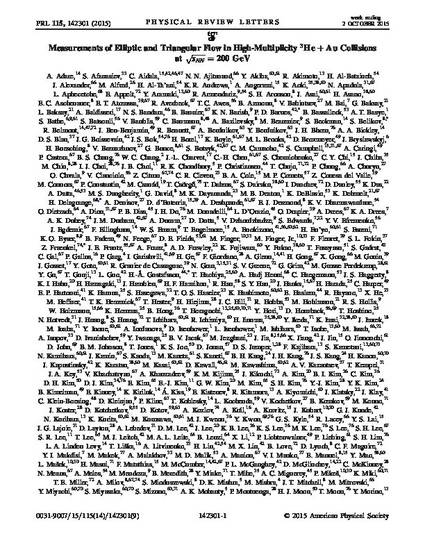
Article
Measurements of Elliptic and Triangular Flow in High-Multiplicity He-3 + Au Collisions at root s(NN)=200 GeV
Physical Review Letters
Document Type
Article
Disciplines
Publication Version
Published Version
Publication Date
9-28-2015
DOI
10.1103/PhysRevLett.115.142301
Abstract
We present the first measurement of elliptic (v(2)) and triangular (v(3)) flow in high-multiplicity He-3 + Au collisions at root s(NN) = 200 GeV. Two-particle correlations, where the particles have a large separation in pseudorapidity, are compared in He-3 + Au and in p + p collisions and indicate that collective effects dominate the second and third Fourier components for the correlations observed in the He-3 + Au system. The collective behavior is quantified in terms of elliptic v(2) and triangular v(3) anisotropy coefficients measured with respect to their corresponding event planes. The v(2) values are comparable to those previously measured in d + Au collisions at the same nucleon-nucleon center-of-mass energy. Comparisons with various theoretical predictions are made, including to models where the hot spots created by the impact of the three He-3 nucleons on the Au nucleus expand hydrodynamically to generate the triangular flow. The agreement of these models with data may indicate the formation of low-viscosity quark-gluon plasma even in these small collision systems.
Copyright Owner
American Physical Society
Copyright Date
2015
Language
en
File Format
application/pdf
Citation Information
Andrew Adare, Nicole Apadula, Sarah C. Campbell, Alan Dion, et al.. "Measurements of Elliptic and Triangular Flow in High-Multiplicity He-3 + Au Collisions at root s(NN)=200 GeV" Physical Review Letters Vol. 115 Iss. 14 (2015) p. 142301 Available at: http://works.bepress.com/craig-ogilvie/37/

This is an article from Physical Review Letters 115 (2015): 142301, doi:10.1103/PhysRevLett.115.142301. Posted with permission.